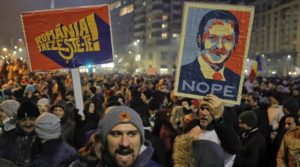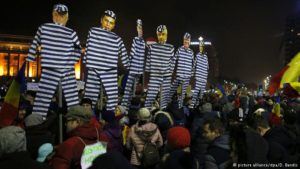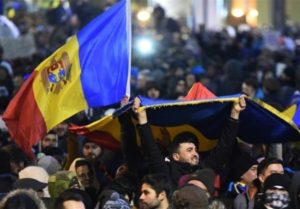A decision of the Social Democrat government to pass an urgent decree, which partly decriminalized the abuse of office and other related misconduct, brought more than half a million Romanian people onto the streets since last week. The government was wrong to pass this decree. There is no doubt that one of the main beneficiaries would have been Liviu Dragnea, the leader of the Social Democrats and Chamber President who is indicted for abuse of office. His case is pending. The argument that the government had to pass this decree in order to respect a previous decision of the Constitutional Court holds no water. Neither does the argument that this decree would ease the overpopulated prison system. If enforced, the decree would favor white-collar employees in the state bureaucracy, not the poorest accused of petty crimes. The measure produced dissatisfaction even among constituencies that voted for the Social Democrats in last year’s elections. For them, as for many other Romanians, clemency for convicted politicians already appears unfair. The way the government decided to go about it – in haste and without transparency – only made things worse.
 Why the PSD acted with such haste, in this particular form, and why they did it immediately after winning the elections that gave them a strong mandate, are secondary questions, and probably irrelevant. We can guess the desperation of Dragnea, but just as well we can observe a way of doing politics brought from the local level where Dragnea cut his political teeth. Also, in the manner in which the decision was made and communicated, there is discernible a clear lack of cadres within the party. Even Chamber President Dragnea, who cut the figure of a high-caliber politician during the campaign because of weak opposition, now appears average. After the elections, he committed a series of blunders, including taking part in Trump’s inauguration. But to add insult to injury he was not even a guest. He had to pay around $1 million, as reported by the press, to have a few bad pictures taken with which to boast on Facebook. Then, he condoned the issue of the decree only to declare, after the fact, that he had no clue what they entailed. This contradictory position of the party ruler was mirrored by the complete silence of most of the membership. With one or two exceptions, there was no dissenting voice.
Why the PSD acted with such haste, in this particular form, and why they did it immediately after winning the elections that gave them a strong mandate, are secondary questions, and probably irrelevant. We can guess the desperation of Dragnea, but just as well we can observe a way of doing politics brought from the local level where Dragnea cut his political teeth. Also, in the manner in which the decision was made and communicated, there is discernible a clear lack of cadres within the party. Even Chamber President Dragnea, who cut the figure of a high-caliber politician during the campaign because of weak opposition, now appears average. After the elections, he committed a series of blunders, including taking part in Trump’s inauguration. But to add insult to injury he was not even a guest. He had to pay around $1 million, as reported by the press, to have a few bad pictures taken with which to boast on Facebook. Then, he condoned the issue of the decree only to declare, after the fact, that he had no clue what they entailed. This contradictory position of the party ruler was mirrored by the complete silence of most of the membership. With one or two exceptions, there was no dissenting voice.
On the other hand, well meaning people took, in all righteousness, to the streets. When you don’t like what the government does, you revolt, you protest. At the same time, it is impossible to deny the fact that these protests were not only against the government plans, but also, evidently, in favor of some state institutions, of power and repression, as well as in favor of President Iohannis. Protests asked for the continuation of the anti-corruption campaign, irrespective of the inherent and well-documented problems of that campaign, of its visible political nature and abuses. Protest against government abuses, but neglect the abuses of the war on corruption? The protests were preceded by the revelation that General Coldea, the second in command of the Romanian Intelligence Service, a staunch pillar of the anti-corruption campaign, had to quit following collusion with a former senator accused of corruption. What distinguished the partisan nature of the protests was this selectivity of attention.
Indignation is normal and the protests are natural. But we find ourselves in an impossible situation. The protests against PSD gave birth to an ample coalition in which well meaning and decent people got together with all sorts of opportunists – yet again. The fact that opposition politicians joined in only made things worse. Inadvertently, as in the past, the PSD managed to revive a moribund Right. Even more, the aestheticism of the protests, their paraphernalia, their national flags and singing of the national anthem – despite their clever and creative slogans – had an obvious right-wing flavor to them. The governmental decree and the street reactions to them reduced the slim chances of a re-articulation of the local Left. In fact, the first victims of the protests were the few leftist voices in PSD which are now discredited because of their silence.
Beyond the immediate occasion of the decree, we witness a pattern. A fraction of society for whom PSD represents absolute evil, the “red plague”, goes to the streets. For the last five years, they have gone into the streets against PSD every year: 2012 (summer), 2013 (Rosia Montana), 2014 (the election campaign of Iohannis), 2015 (Colectiv), and now, in 2017, after PSD won a majority of the parliamentary seats. Therefore, as journalist Horatiu Pepine noted, these street protests also come as a reaction to PSD winning the election – it was a posteriori cry. PSD won not only because it was voted for, but also because the opposition didn’t get enough votes. The decree not only provoked strong reactions against PSD as a party, but also, as we might expect based on the dynamics of the previous years, against PSD voters too. This, in fact, is a permanent danger: behind the indignation against PSD and its actions lurks the specter of hatred against its voters. Costi Rogozanu explained very well that behind the facile opposition of ‘metropolitan’ and ‘teleromanian’ Romania stands a series of fractions between class interests and, especially, a neglected history of legal abuses to the benefit of capital, small and large, local and global. The war against corruption did not (and could not) target these, just as it did not consider the fact that the effects of the post-socialist transition have been dramatic for most.
 As it stands, we have a conflict between a corrupt PSD and the people, or at least the better part of the people, its worse part voting with PSD. The indignation in face of the decrees and the street mobilizations will only strengthen this impression. But the real confrontation is of another nature, and a more serious one. We are in a very concrete political situation in which PSD still represents the political expression of the interests and aspirations of a part of the population. Their opponents did not succeed in giving a political expression to their own interests, or if they did, it is now irrelevant in the parliamentary game, and, what seems worse, they don’t even seem to truly wish for it. Rather, they aim to impose their interests in a direct way upon the state, without the mediation of elections. The chant of “I vote DNA!” [National Anti-Corruption Directorate] is not only a journalistic formula, but also the expression of this latter expectation for certain state institutions to become the carriers of the popular will outside of the electoral system. In such conditions, popular support goes from the street directly to institutions. So the protests are not simply anti-PSD, but, implicitly, in favor of some state institutions. It is a situation almost without any precedent, in which the opponents of a government are not trying to put their own politicians in its place, but want them to fall so that they do not hamper the activity of other state institutions.
As it stands, we have a conflict between a corrupt PSD and the people, or at least the better part of the people, its worse part voting with PSD. The indignation in face of the decrees and the street mobilizations will only strengthen this impression. But the real confrontation is of another nature, and a more serious one. We are in a very concrete political situation in which PSD still represents the political expression of the interests and aspirations of a part of the population. Their opponents did not succeed in giving a political expression to their own interests, or if they did, it is now irrelevant in the parliamentary game, and, what seems worse, they don’t even seem to truly wish for it. Rather, they aim to impose their interests in a direct way upon the state, without the mediation of elections. The chant of “I vote DNA!” [National Anti-Corruption Directorate] is not only a journalistic formula, but also the expression of this latter expectation for certain state institutions to become the carriers of the popular will outside of the electoral system. In such conditions, popular support goes from the street directly to institutions. So the protests are not simply anti-PSD, but, implicitly, in favor of some state institutions. It is a situation almost without any precedent, in which the opponents of a government are not trying to put their own politicians in its place, but want them to fall so that they do not hamper the activity of other state institutions.
Dacian Ciolos’s technocratic government, together with his aspiration to remain Prime Minister without running for elections, are eloquent in this sense, but not the most important elements. The autonomy of the police and repressive forces of the state, as well as their complete decoupling from any political and public control are much more significant. In fact, a branch of state institutions, a constellation of institutions linked by multiple invisible relations (these breaching on, and sometimes blending into illegality), untouched by any political control, or even of independent supervision. By now, it seems that even the national budget can be taken out of the field of politics to one in which the control of the latter is suspended, with special regards to the budget of the secret services.
The collateral victim, of course, is democracy, in its most liberal-bourgeois sense. It is bizarre therefore that those who made a career by defending democracy are now silent, faced with this situation. For years now, the principle of division of state powers has been annulled (the legislative branch has been gutted, its control over the judiciary nonexistent). Moreover, we see a rupture between the branches of the executive (between the president’s office and the government). State institutions now are organized on two axes: on the one hand, the president’s office and law enforcement, on the other the government and its sub-institutions). It is not by chance that as soon as the decree was passed, President Iohannis went to the Superior Magistrates Council in order to find a common solution for its cancellation. This is in fact the main contradiction in Romanian politics, one to which all other contradictions are subordinated – and made, in the last instance, irrelevant. This main contradiction brings into its vortex the street protests too, the latter becoming inevitably a force in support of the axis of the president.
Yes, the rulings have to be opposed. The problem is that the protests do not solve the main problem. The situation seems to be a dead-end. On the one hand, we have PSD, representing the politics of small and medium provincial cities, characterized by local complicity, clans, families, phylum, very hierarchical, based on unconditional loyalty, intolerant towards any sort of dissidence or counter-opinion, generous towards its members and relentless towards enemies, conservative and racist. What they do not represent is the poor (who are ghettoized and excluded from publicity especially in small and medium towns), not even the most precarious proletarians. They represent the small bourgeoisie of provincial cities and their white-collar workers. PSD works as a minimal social security for them, guaranteeing a very patriarchal system of redistribution of the fruits of underdevelopment. On the opposite pole, the coercive institutions of the state, increasingly autonomized from government control, is led and populated by career bureaucrats, who have monthly wages that put them in the top 5%, have been extracted from under popular control, and don’t believe in the formal institutions of democracy precisely because, through the mechanisms of the latter, the popular classes can bring to power corrupt politicians.
 However, what lurks behind this opposition is, as always, class. The Social Democrats increased the minimum wage, the pensions, cut taxes for the poorest segments and increased (just slightly) social welfare spending. They will need to balance out these measures by rethinking taxation, especially by scrapping the flat tax and by taxing the richer segments and the corporate incomes. Faced with such prospects, it is not at all surprising that corporate workers, and especially their bosses, were on the streets to protest. People in Bucharest’s corporations were offered free days off work to be able to stay up at night and protest against the government. McDonalds offered free tea to protesters to stay warm and rehydrate. The local head of Raiffeisen bank, a bank accused of cheating on tens of thousands of Romanians through the trick of slipping abusive clauses in their contracts, brought his family to the protests. Journalists and other media pundits, who in the past already decried the social measures of the government as reckless spending, tuned in an added their messages against the government. Little wonder in this context that the protests quickly moved from a specific demand regarding the decree, to the resignation of the newly appointed government as a whole.
However, what lurks behind this opposition is, as always, class. The Social Democrats increased the minimum wage, the pensions, cut taxes for the poorest segments and increased (just slightly) social welfare spending. They will need to balance out these measures by rethinking taxation, especially by scrapping the flat tax and by taxing the richer segments and the corporate incomes. Faced with such prospects, it is not at all surprising that corporate workers, and especially their bosses, were on the streets to protest. People in Bucharest’s corporations were offered free days off work to be able to stay up at night and protest against the government. McDonalds offered free tea to protesters to stay warm and rehydrate. The local head of Raiffeisen bank, a bank accused of cheating on tens of thousands of Romanians through the trick of slipping abusive clauses in their contracts, brought his family to the protests. Journalists and other media pundits, who in the past already decried the social measures of the government as reckless spending, tuned in an added their messages against the government. Little wonder in this context that the protests quickly moved from a specific demand regarding the decree, to the resignation of the newly appointed government as a whole.
On February 5, the day that marked the biggest numbers of people in the streets, the government backed down and cancelled the decree. It opted for a normal parliamentary procedure to make the desired changes. Already, the political scandal moved inside the parliament where next year’s budget is being discussed. Following the government’s decision protesters still came out on the streets, but the numbers dwindled significantly and the energy is definitely lower. The counter-manifestation that started yesterday against the President and in support of the government, that never reached 1000 to begin with, is expected to fizzle out even sooner. For now, the political turmoil seems to be abetting, but the deeper social and political fracture lines are still there and deeper than ever. These protests only magnified them and brought them into play briefly. That these antagonisms will explode again is only a matter of time.
Translated by Anges Gagyi.


2 replies on “What is at stake in the Romanian Protests?”
I don’t understand this: you are, as it seems from the language, against bourgeois (capitalist) democracy, but you mentioned that Romania is in post-socialist era. So once there was socialism in Romania?
Yes. State socialism. Or semi-socialism